Related Research Articles

Sir John Everett Millais, 1st Baronet was an English painter and illustrator who was one of the founders of the Pre-Raphaelite Brotherhood. He was a child prodigy who, aged eleven, became the youngest student to enter the Royal Academy Schools. The Pre-Raphaelite Brotherhood was founded at his family home in London, at 83 Gower Street. Millais became the most famous exponent of the style, his painting Christ in the House of His Parents (1849–50) generating considerable controversy, and he produced a picture that could serve as the embodiment of the historical and naturalist focus of the group, Ophelia, in 1851–52.
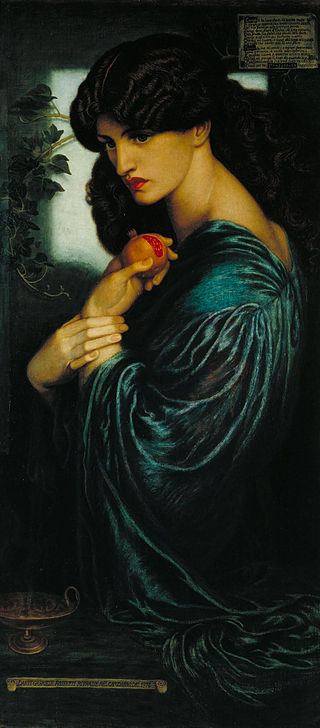
The Pre-Raphaelite Brotherhood was a group of English painters, poets, and art critics, founded in 1848 by William Holman Hunt, John Everett Millais, Dante Gabriel Rossetti, William Michael Rossetti, James Collinson, Frederic George Stephens and Thomas Woolner who formed a seven-member "Brotherhood" partly modelled on the Nazarene movement. The Brotherhood was only ever a loose association and their principles were shared by other artists of the time, including Ford Madox Brown, Arthur Hughes and Marie Spartali Stillman. Later followers of the principles of the Brotherhood included Edward Burne-Jones, William Morris and John William Waterhouse.
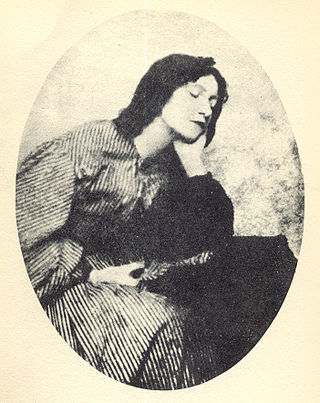
Elizabeth Eleanor Siddall, better known as Elizabeth Siddal, was an English artist, art model, and poet. Siddal was perhaps the most significant of the female models who posed for the Pre-Raphaelite Brotherhood. Their ideas of female beauty were fundamentally influenced and personified by her. Walter Deverell and William Holman Hunt painted Siddal, and she was the model for John Everett Millais's famous painting Ophelia (1852). Early in her relationship with Dante Gabriel Rossetti, Siddal became his muse and exclusive model, and he portrayed her in almost all his early artwork depicting women.

Henry Scott Tuke was an English artist. His most notable work was in the Impressionist style and he is best known for his paintings of nude boys and young men.
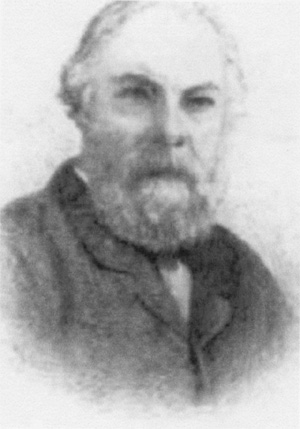
John William Inchbold was an English painter who was born in Leeds, Yorkshire. His style was influenced by the Pre-Raphaelite Brotherhood. He was the son of a Yorkshire newspaper owner, Thomas Inchbold.

Simeon Solomon was a British painter associated with the Pre-Raphaelites who was noted for his depictions of Jewish life and same-sex desire. His career was cut short as a result of public scandal following his arrests and convictions for attempted sodomy in 1873 and 1874.

John Roddam Spencer Stanhope was an English artist associated with Edward Burne-Jones and George Frederic Watts and often regarded as a second-wave pre-Raphaelite. His work is also studied within the context of Aestheticism and British Symbolism. As a painter, Stanhope worked in oil, watercolor, fresco, tempera, and mixed media. His subject matter was mythological, allegorical, biblical, and contemporary. Stanhope was born in Cawthorne, near Barnsley, Yorkshire, England, and died in Florence, Italy. He was the uncle and teacher of the painter Evelyn De Morgan and encouraged then unknown local artist Abel Hold to exhibit at the Royal Academy, which he did 16 times.
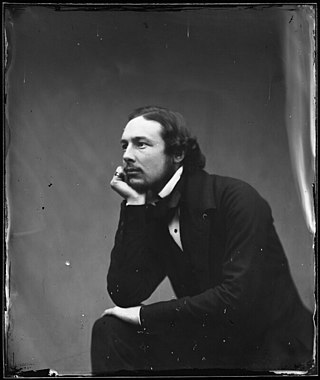
George Price Boyce was a British watercolour painter of landscapes and vernacular architecture in the Pre-Raphaelite style. He was a patron and friend of Dante Gabriel Rossetti.
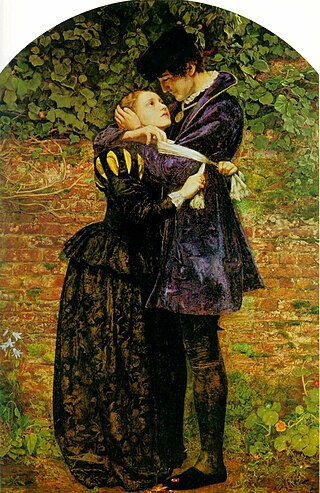
A Huguenot, on St. Bartholomew's Day, Refusing to Shield Himself from Danger by Wearing the Roman Catholic Badge (1851–52) is the full, exhibited title of a painting by John Everett Millais, and was produced at the height of his Pre-Raphaelite period. It was accompanied, at the Royal Academy of Arts in London in 1852, with a long quote reading: "When the clock of the Palais de Justice shall sound upon the great bell, at daybreak, then each good Catholic must bind a strip of white linen round his arm, and place a fair white cross in his cap.—The order of the Duke of Guise." This long title is usually abbreviated to A Huguenot or A Huguenot, on St Bartholomew's Day.
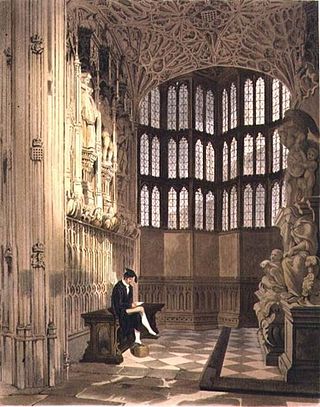
Thomas Uwins was a British portrait, subject, genre and landscape painter in watercolour and oil, and a book illustrator. He became a full member of the Old Watercolour Society and a Royal Academician, and held a number of high-profile art appointments including the librarian of the Royal Academy, Surveyor of Pictures to Queen Victoria and the Keeper of the National Gallery.

Frederick Cayley Robinson was an English artist who created paintings and applied art, including book illustrations and theatre set designs. Cayley Robinson continued to paint striking Pre-Raphaelite and Victorian subjects well into the twentieth century despite this approach becoming deeply unfashionable.
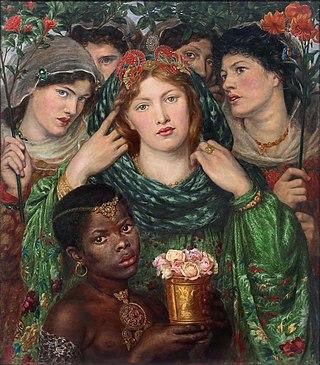
The Beloved is an oil painting on canvas by the English artist Dante Gabriel Rossetti (1828–1882), now in Tate Britain, London. Rossetti signed his initials and the date as "1865-6" on the bottom left of the canvas. It depicts the bride, or "beloved", from the Song of Solomon in the Hebrew Bible as she approaches her bridegroom, with her attendants.

Gaetano Giuseppe Faostino Meo was an Italian-British artist's model, landscape painter, and a noted craftsman in mosaic and stained glass. His unpublished autobiography is a useful source for art historians of the Aesthetic Movement and Edwardian Era.

Candaules, King of Lydia, Shews his Wife by Stealth to Gyges, One of his Ministers, as She Goes to Bed, rarely known as The Imprudence of Candaules, is a 45.1 by 55.9 cm oil painting on canvas by English artist William Etty, first exhibited at the Royal Academy in 1830. It shows a scene from the Histories by Herodotus, in which Candaules, king of Lydia, invites his bodyguard Gyges to hide in the couple's bedroom and watch his wife Nyssia undress, to prove to him her beauty. Nyssia notices Gyges spying and challenges him to either accept his own execution or to kill Candaules as a punishment. Gyges chooses to kill Candaules and take his place as king. The painting shows the moment at which Nyssia, still unaware that she is being watched by anyone other than her husband, removes the last of her clothes.
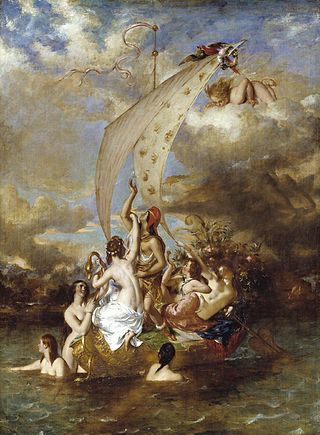
Youth on the Prow, and Pleasure at the Helm is an oil painting on canvas by English artist William Etty, first exhibited in 1832. Etty had been planning the painting since 1818–19, and an early version was exhibited in 1822. The piece was inspired by a metaphor in Thomas Gray's poem The Bard in which the apparently bright start to the notorious misrule of Richard II of England was compared to a gilded ship whose occupants are unaware of an approaching storm. Etty chose to illustrate Gray's lines literally, depicting a golden boat filled with and surrounded by nude and near-nude figures.
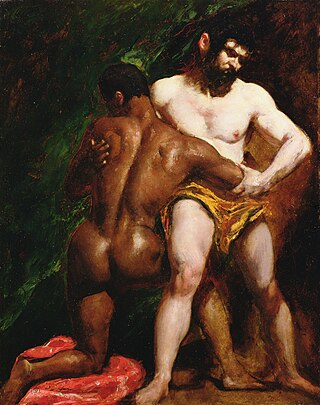
The Wrestlers is an oil painting on millboard by English artist William Etty, painted around 1840 and currently in the York Art Gallery, in York, England. It depicts a wrestling match between a black man and a white man, both glistening with sweat and under an intense light emphasising their curves and musculature. While little documentation of the painting exists prior to 1947, it is likely that it was painted over a period of three evenings at the life class of the Royal Academy.

Musidora: The Bather 'At the Doubtful Breeze Alarmed', also known as The Bather, is a name given to four nearly identical oil paintings on canvas by English artist William Etty. The paintings illustrate a scene from James Thomson's 1727 poem Summer in which a young man accidentally sees a young woman bathing naked and is torn between his desire to look and his knowledge that he ought to look away. The scene was popular with English artists as it was one of the few legitimate pretexts to paint nudes at a time when the display and distribution of nude imagery was suppressed.
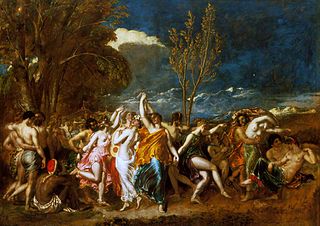
The World Before the Flood is an oil-on-canvas painting by the English artist William Etty, first exhibited in 1828 and currently in the Southampton City Art Gallery. It depicts a scene from John Milton's Paradise Lost in which, among a series of visions of the future shown to Adam, he sees the world immediately before the Great Flood. The painting illustrates the stages of courtship as described by Milton: a group of men select wives from a group of dancing women, drag their chosen woman from the group, and settle down to married life. Behind the courting group, an oncoming storm looms, foreshadowing the destruction which the dancers and lovers are about to bring upon themselves.

Britomart Redeems Faire Amoret is an oil painting on canvas by English artist William Etty, first exhibited in 1833 and now in Tate Britain. Intended to illustrate the virtues of honour and chastity, it depicts a scene from Edmund Spenser's The Faerie Queene in which the female warrior Britomart slays the evil magician Busirane and frees his captive, the beautiful Amoret. In Spenser's original poem Amoret has been tortured and mutilated by the time of her rescue, but Etty disliked the depiction of violence and portrayed her as unharmed.
Richard Dorment, is a British art historian and exhibition organiser. He worked as chief art critic for The Daily Telegraph from 1986 until 2015.
References
- ↑ "Wallace Collection Trustees Minutes" (PDF). Retrieved 1 January 2025.
- ↑ "Female Voices in Art: Alison Smith" . Retrieved 1 January 2025.